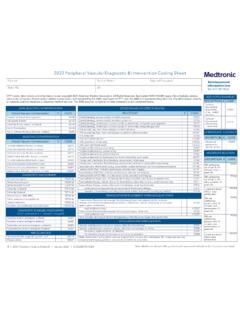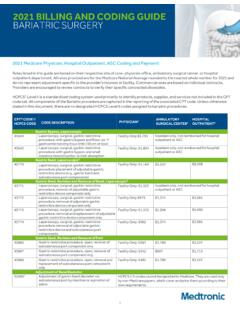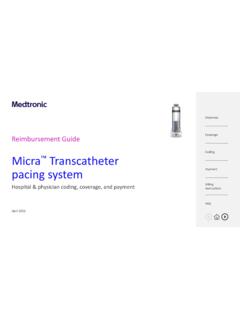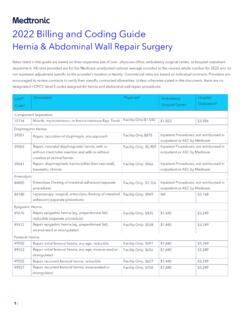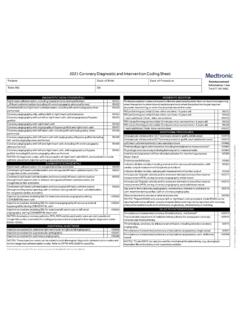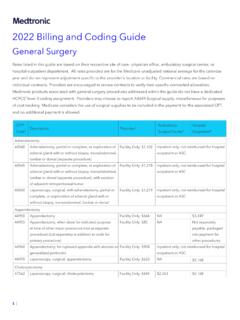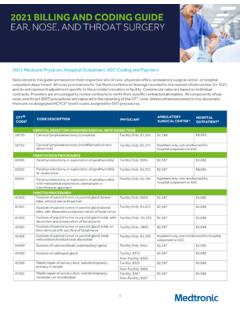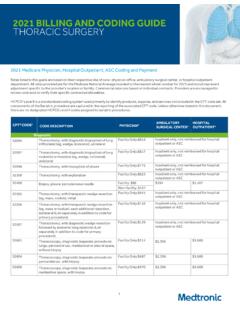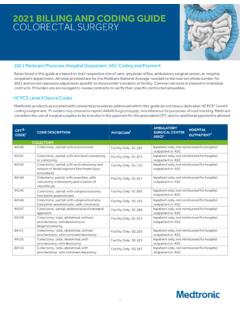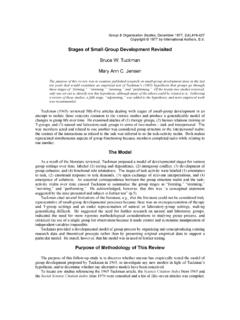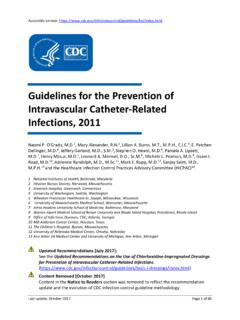Transcription of 2021 BILLING AND CODING GUIDELINES HEMODIALYSIS …
1 2021 BILLING AND CODING GUIDELINES . HEMODIALYSIS CATHETERS. Overview of Central Venous Access Catheters for HEMODIALYSIS Medtronic produces a variety of catheters used to perform HEMODIALYSIS in patients with renal failure. These catheters are Central Venous Access Catheters, intended to be inserted via a central vein typically, the jugular, subclavian, brachiocephalic, or femoral veins. Once inserted, the internal tip of the catheter is advanced into the superior or inferior vena cava or into the right atrium of the heart. To be used for HEMODIALYSIS , the catheters have two lumens with two caps that hang outside the body. All Medtronic dialysis catheters are centrally inserted. CPT *1 also provides codes for peripherally inserted catheters (PICC). These codes are not addressed within the guide. Procedures Using HEMODIALYSIS Catheters There are seven different types of procedures that can be performed using central venous access devices: (1) Insert; (2) Replace; (3) Remove; (4) Repair; (5) Remove Obstruction; (6) Reposition; or (7) Evaluate Catheter Each procedure has a specific set of CPT codes, as shown in the table below.
2 Different CPT codes are used depending on several factors including: Non-tunneled (acute, short term use) or tunneled (chronic, long-term use). Patient's age (< 5, age 5 and older). REPLACE. MEDTRONIC REMOVE. CATHETER TYPE INSERT (VIA SAME REMOVE REPAIR REPOSITION EVALUATE. PRODUCT TYPE OBSTRUCTION. ACCESS). 36555 Declotting: (<5 years) 36593. Non-tunneled Acute 36580 E/M code 36556. (>5years) Outside catheter: 36595, 36597. 75901 & &. 36575 36598. 36557 36010-36012 76000. (<5years). Tunneled Chronic 36581 36589 Inside catheter: 36558. (>5 years) 36596, 79502. & 36010-36012. 1. Reimbursement for HEMODIALYSIS Catheters Rates listed in this guide are based on their respective site of care - physician office, ambulatory surgical center, or hospital outpatient department. All rates provided are for the Medicare National Average for the calendar year rounded to the nearest whole number and do not represent adjustment specific to the provider's location or facility.
3 Commercial rates are based on individual contracts. Providers are encouraged to review contracts to verify their specific contracted allowables. HCPCS2 Device Codes For procedures performed in the office where the physician incurs the cost of the catheter, the physician can bill the HCPCS. A-code for the catheter in addition to the CPT * code for the procedure of placing it. However, many payers include payment for the device in the payment for the CPT * procedure code and do not pay separately for the catheter. Similarly, hospitals can bill HCPCS codes for the supplies in addition to the CPT * code for the procedure. For Medicare, hospitals use C-codes for the catheter as well as the guidewires and introducer sheaths. However, the C-codes are not paid separately because payment for these items is included in the payment for the CPT procedure code.
4 For non-Medicare payers, hospitals typically use the HCPCS A-code. Although many payers include payment for the device in the payment for the CPT procedure code and do not pay separately for the catheter itself, some payers may do so. Hospitals use HCPCS. codes only on outpatient bills. HCPCS codes are not used on inpatient hospital bills. Medicare specifically instructs ASCs not to bill HCPCS codes for devices that are packaged into the payment for the CPT * code, as is the case for central venous catheters for catheters. HCPCS CODE DESCRIPTION. A4300 Implantable access catheter ( , venous, arterial, epidural subarachnoid, or peritoneal, etc.), external access C1750 Catheter, HEMODIALYSIS /peritoneal, long-term C1769 Guidewire C1894 Introducer sheath Insertion of Catheter As noted, different CPT * codes are assigned depending on whether the catheter is non-tunneled ( , for acute, short- term use).
5 Or tunneled ( , for chronic, long-term use) and the patient's age. AMBULATORY. HOSPTIAL. CPT *CODE2 DESCRIPTION PHYSICIAN3 SURGICAL. OUTPATIENT4. CENTER4. 36555 Insertion of non-tunneled centrally inserted central venous Facility:$202 $1,365 $2,862. catheter, younger than 5 years of age Non-Facility:$85. 36556 Insertion of non-tunneled centrally inserted central venous Facility:$229 $1,365 $2,862. catheter, age 5 years or older Non-Facility:$86. 36557 Insertion of tunneled centrally inserted central venous Facility:$1,245 $2,369 $4,770. catheter, without subcutaneous port or pump, younger than 5 years of age Non-Facility:$329. 36558 Insertion of tunneled centrally inserted central venous catheter, Facility:$891 $1,365 $2,862. without subcutaneous port or pump, age 5 years or older Non-Facility: $264. 2. Replacement of Catheter Via Separate Venous Access: If replacement involves removing an existing dialysis catheter and inserting a new dialysis catheter via separate venous access, two codes may be assigned: (1) insertion of the new catheter (see Insertion Table above), and (2).
6 Removal of the old catheter (see Removal Table below). Both codes can be billed together, and no modifier is required. Via Same Venous Access: The codes below are assigned when replacement involves removing the existing dialysis catheter and inserting the new dialysis catheter through the same venous access site, , over-the-wire. Codes differ depending on whether the catheter is non-tunneled or tunneled. AMBULATORY. HOSPTIAL. CPT * CODE2 DESCRIPTION PHYSICIAN3 SURGICAL. OUTPATIENT4. CENTER4. 36580 Replacement, complete, of a non-tunneled centrally inserted central Facility:$218 $741 $1,406. venous catheter, without subcutaneous port or pump, through same venous access Non-Facility:$67. 36581 Replacement, complete, of a tunneled centrally inserted central Facility:$862 $1,365 $2,862. venous catheter, without subcutaneous port or pump, through same venous access Non-Facility:$186.
7 Removal of Catheter Dialysis catheters are removed both during replacement and also when a patient receiving acute, short-term therapy no longer requires dialysis. There is no procedure code for removal of a non-tunneled central venous catheter, , removal by pull after the sutures are removed. An E/M office visit code can be billed as appropriate for the visit during which the removal took place. Removal of tunneled catheters, however, requires surgical dissection to release the catheter. AMBULATORY. HOSPTIAL. CPT * CODE2 DESCRIPTION PHYSICIAN3 SURGICAL. OUTPATIENT4. CENTER4. 36589 Removal of tunneled central venous catheter, without subcutaneous Facility:$172 $274 $542. port or pump Non-Facility:$141. Imaging Guidance for Insertion, Replacement, and Removal Two additional codes can be billed for imaging guidance.
8 These codes must be billed with a catheter insertion, replacement, or removal code. The code depends on the type of imaging used. If both ultrasound guidance and fluoroscopic guidance are performed, both 76937 and 77001 can be assigned together with the dialysis catheter code. AMBULATORY. HOSPTIAL. CPT * CODE2 DESCRIPTION PHYSICIAN3 SURGICAL. OUTPATIENT4. CENTER4. +76937 Ultrasound guidance for vascular access requiring US evaluation of Facility:$39 NA NA. potential access sites, documentation of selected vessel patency, concurrent real-time US visualization of vascular needle entry, with Non-Facility:$14. permanent recording & reporting +77001 Fluoroscopic guidance for central venous access device Facility:$105 NA NA. placement, replacement, or removal (includes fluoroscopic guidance for vascular access and catheter manipulation, any necessary contrast injections through access site or catheter Non-Facility:$19.)
9 With related venography, radiologic supervision and interpretation and radiographic documentation of final catheter position). 3. Repair of Catheter Some catheters can be repaired, for example by replacing a damaged or non-functioning component. There is only one code for repair. AMBULATORY. HOSPTIAL. CPT *CODE2 DESCRIPTION PHYSICIAN3 SURGICAL. OUTPATIENT4. CENTER4. 36575 Repair of tunneled or non-tunneled central venous access catheter, Facility:$167 $274 $542. without subcutaneous port or pump, central or peripheral insertion Non-Facility:$35. site Removal of Obstruction from Catheter There are three ways to remove clots and thrombus, fibrin sheaths, and other obstructive material from dialysis catheters: (1) declotting by injection, (2) removing external obstruction, or (3) removing internal obstruction. AMBULATORY.
10 HOSPTIAL. CPT * CODE2 DESCRIPTION PHYSICIAN3 SURGICAL. OUTPATIENT4. CENTER4. Declotting catheter by injecting thrombolytic agent ( , Urokinase or tPA) into the catheter 36593 Declotting by thrombolytic agent of implanted vascular access device or Non-Facility Only: $33 $311. catheter $33. Note: Code 36593 is not payable to the physician when performed in a hospital or ambulatory surgery center, because the service is typically performed by a facility-employed nurse. Removing obstruction from around the outside of catheter ( , stripping a fibrin sheath off a catheter with a snare): Three codes are needed to describe the procedure: (1) 36595 to remove obstruction; (2) 75901 for associated imaging; and (3) 36010-36012, depending on the vein, for placing the snare. 36595 Mechanical removal of pericatheter obstructive material ( , fibrin Facility:$658 $1,775 $2,862.)
